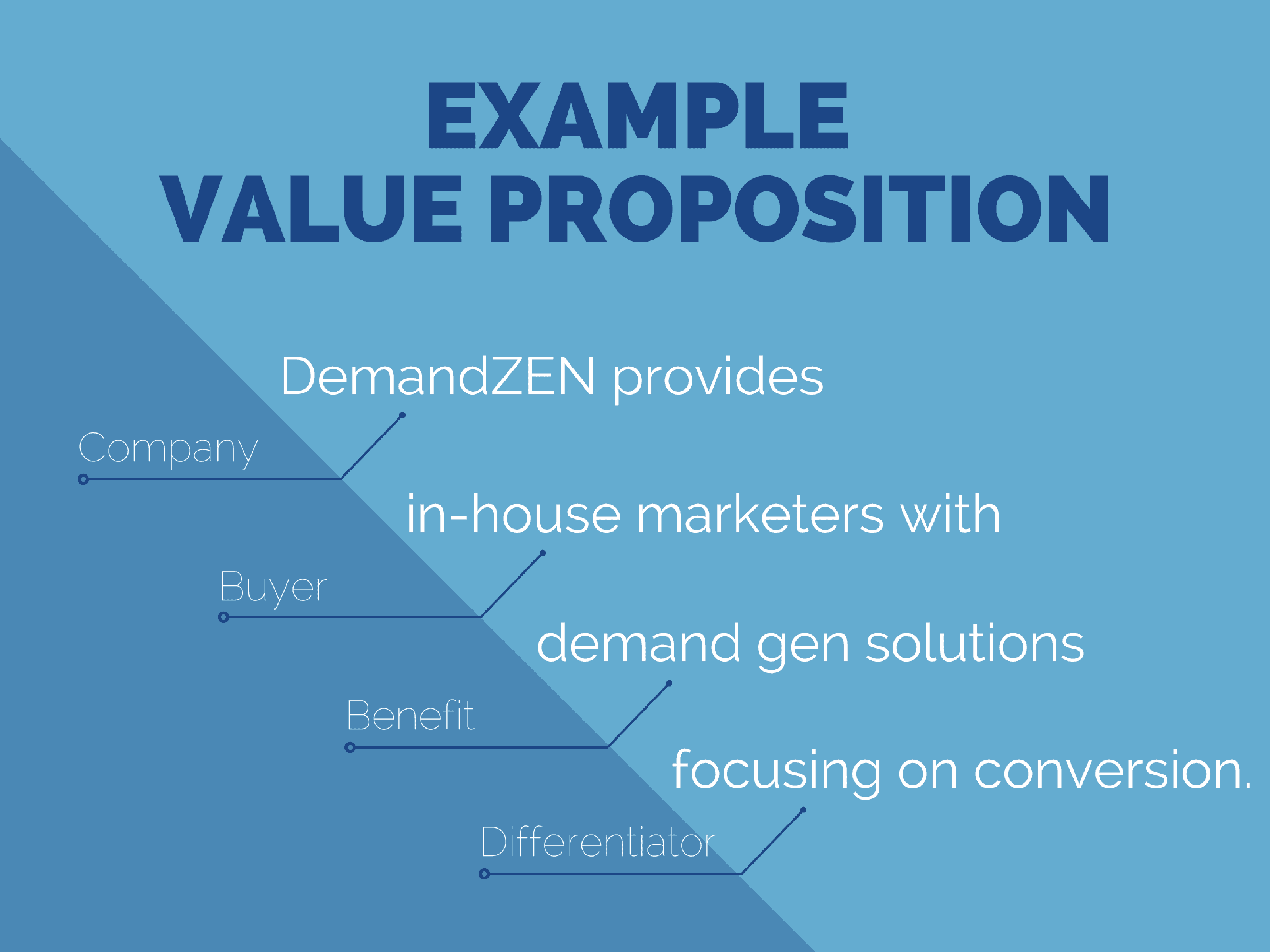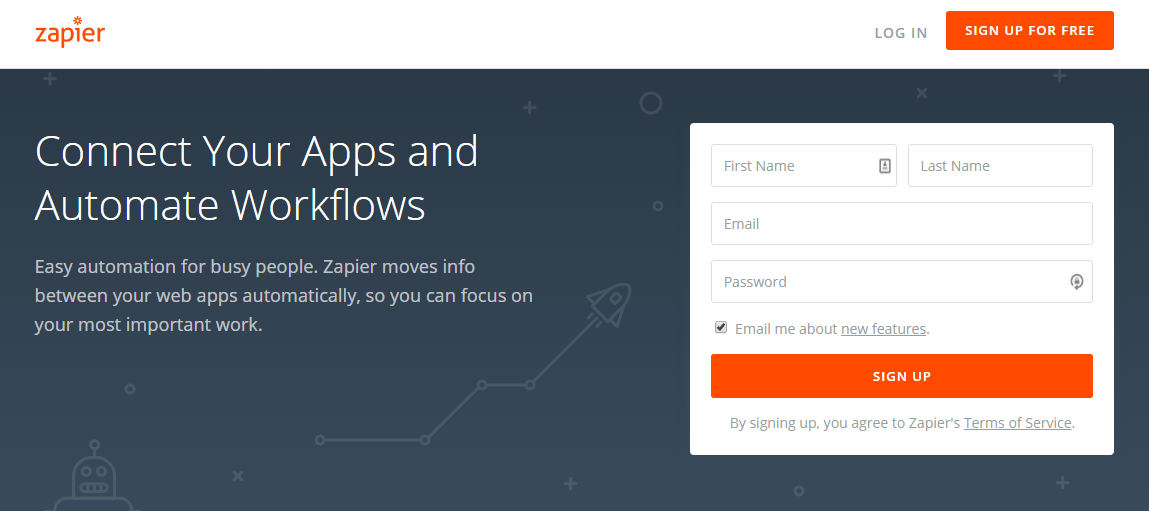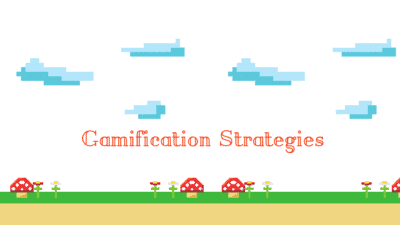How To: Write a Value Proposition

A value proposition will probably be the shortest thing you ever write after doing hours of research. To write a value proposition that works, DemandZEN is here to guide you in the right direction.
Why you need to write a value proposition
A value proposition is a sentence or two that clearly demonstrates the benefit of a product or service while also targeting a specific customer group. The length of a value proposition is really important, as you should create “tiers” of value propositions based on who exactly you’re targeting and how in-depth you want to make your benefit and product descriptions. While your two-sentence proposition will be the one that gets the most usage, we also recommend creating four and seven sentence value propositions. The same rules apply with these longer propositions, and they allow you to expand on your company for longer form content without having to recreate it every time.
Value propositions are used in sales and marketing, and it should be shared with your customer. This isn’t a marketing tool that should stay behind closed doors. Everyone should see it, use it, and be swayed by it.
Wikipedia goes as far as stating that a value proposition “should form the anchor for all decision-making, operations, and customer engagement.” That’s spot on. Despite being short, your value proposition will hold a lot of influence over your business. That’s why you can’t just write down the first sentence that comes to mind and call it a day.
Customers don’t want to do work to figure out what it is you’re selling. That’s why you need to clearly communicate what your product or service is and who will benefit from it. It’s up to you to effectively relate to the customer what your product is and make a case for it. Putting this at the top of your homepage works to your advantage: tell customers exactly who you are and what you do without them taking any additional actions.
You can also use a dedicated value proposition page as a landing page for your ads. Sales representatives can navigate customers to this page if the customer doesn’t have time to discuss the product.
Let’s go down the list and see exactly how to write a value proposition–and how to make it great.
Clearly define your product or service
What exactly is your product and what does it do? You need to start with a deep understanding of your product before you can convey it to customers. Try describing your service multiple ways to different people inside and outside of your company to see what resonates.
If you can describe the functionality of your product between three and five words, that leaves you with more room to highlight the other aspects of your product when you sit down and actually write a value proposition.
Identify your buyers
You’ll need to do some research to find out who your customer base is. If you haven’t already created buyer personas, now is a great time to do that. If you have, use that same research and the buyer personas themselves to craft your value proposition.
You shouldn’t be conducting separate research for your value proposition and personas. All of your targeted content should be aimed at the same personas, otherwise you’re going to have a very mismatched and confused marketing strategy.
If you don’t address your target audience directly in your value proposition, make sure you’re using language that is relevant to them. Use phrases that only a developer would understand if you want to speak to developers. When your target is non-technical users, phrase things more simply.
List the benefits
What will users get out of your product besides the service itself? Here’s where you get to emphasize all of those little perks that flesh out your product. Having that clear definition we discussed earlier will allow you to list out benefits with ease.
Appeal to your buyer’s needs
You can’t define a benefit without knowing the need behind it. After you establish thorough buyer personas, you should have a concrete idea of what your customers’ biggest needs are. These can be professional or emotional needs depending on your product.
Stephen Reiss is an American psychologist who identified 16 basic desires (or needs) that motivate all humans. The following 16 desires are accepted in the psychological community and have been applied successfully in sports psychology, leadership training, and other disciplines:
- Power
- Curiosity
- Independence
- Status
- Social contact
- Honor
- Idealism
- Physical exercise
- Romance
- Family
- Order
- Eating
- Acceptance
- Tranquility
- Saving
Some of us are more motivated by certain factors than others. And some desires will never fit into your marketing strategy (vengeance and romance? I don’t think so). But by focusing on your customers’ biggest needs as defined by Reiss, you can really get to the heart of why your product is necessary.
When you are developing what your customers need, you need to be careful not to react to false needs. In 2009, Walmart decided they knew what their customers wanted and then asked them if they wanted it. They got a positive response but the result was wasted money. Don’t establish customer needs that are based on your own hypotheses. Ask open-ended questions in the research phase to get the best responses.
Position yourself against your competition
Look at your competition and see what they’re touting. What can you bring to the table that they can’t? What’s the difference maker?
What sets you apart might not be the product itself, and that’s okay. Emphasize your company culture, the users of your product, your methodology when creating the product–whatever is unique to you when compared to competitors in the field.
Include a visual (or two)
An image, video, or an example of what your product does goes a long way. You can create a better idea of what exactly can be accomplished with your product. Another benefit of utilizing an image is generating an immediate understanding of the product after landing on the page. Sometimes it’s worth it to spend the time making a powerful image to match your value proposition.
Expand on your value proposition with a video. This is a place where you might be able to include all of those extra details you love but couldn’t really fit in a single sentence. Make sure to use effective visuals: people using your product (both live-action and cartoon illustrations are great), use graphs to break down the problem your product solves, or take users through a tutorial. They might want to get started a little quicker.
Another visual you can include is an example of your product or a way for users to test it out. These can be screenshots, a demo, or even free browsing of a section of your product. Allow customers to do this right on your homepage.
Statistics matter
Facts are great, but you need to back them up. Using numbers to prove a point is a great strategy. Customers feel reassured when they see proof of what you’re claiming. This is especially important in industries where customers are more skeptical.
Don’t forget to include your sources!
As stated before, your statistics can become another appealing visual that you can use.
Lean on your resources
When you write a value proposition, it needs to be supported by other content. Remember that your product or service is more than just a simple sentence.
Link to a detailed features list so you can really elaborate on your product. Have a use cases page so people understand the benefits and where exactly your product should be used. Customer testimonials are another great asset if you have them–you shouldn’t be the one doing all the talking, after all.
Attributes of a great value proposition
- Short – The shorter the better. If you can convey your message in 15 words, do it.
- Specific – Don’t beat around the bush. What problems does your product solve and why should I use it? As a consumer, I want that information to be clear. I don’t want to have to read between the lines or find the information on my own.
- Attractive – This can be subjective, but there are so many guides out there to help you with the design of your value proposition. Including images, negative space, and harmonious colors are just a few design elements to be conscious of.
- Relevant visuals – Beware of using a pretty image that doesn’t work with the product you’re selling. If you need to explain it to your boss, I guarantee your customer won’t get it, either. After all, your boss knows your product pretty well.
- Don’t repeat yourself – Don’t attempt to stress your message by using repetition. Choose compelling words that get your point across instead. In the same vein, don’t mention the name of your company or product more than once. You might want to draw attention to your brand, but not at the expense of your word count.
Examples
Here are a few examples of value propositions we’re totally into.
Zapier
Why do I like Zapier’s value proposition? It calls out its customers: busy people. It’s an all-inclusive persona that reinforces the usability of Zapier. Users understand immediately this product will minimize the actions they take in a day so they can focus on what matters most to them.
Wrike
Why am I so into Wrike’s homepage? Their product is obvious. Their value proposition tells me I can get more done with them. They also mention some numbers to back up how trustworthy they are–if millions of people have already signed on, why shoudn’t I? An easy “Get started for free” button doesn’t hurt, either.
Venngage
Venngage doesn’t waste any verbiage. Their value proposition gets to the point in 15 words–my dream target. The image they use highlights their product, and they reassure their customers that they have everything necessary to create awesome infographics.
The next time you attempt to write a value proposition, get help from DemandZEN. Contact us about your marketing strategy today.
You Might Also Enjoy These Posts
Demand Generation vs Lead Generation
Gamification Strategies: Badges in B2B Marketing
Welcome To DemandZEN
DemandZEN specializes in Account-Based Demand Generation and solving the challenges around finding, engaging and converting target accounts into real opportunities for B2B Technology and Services companies.







